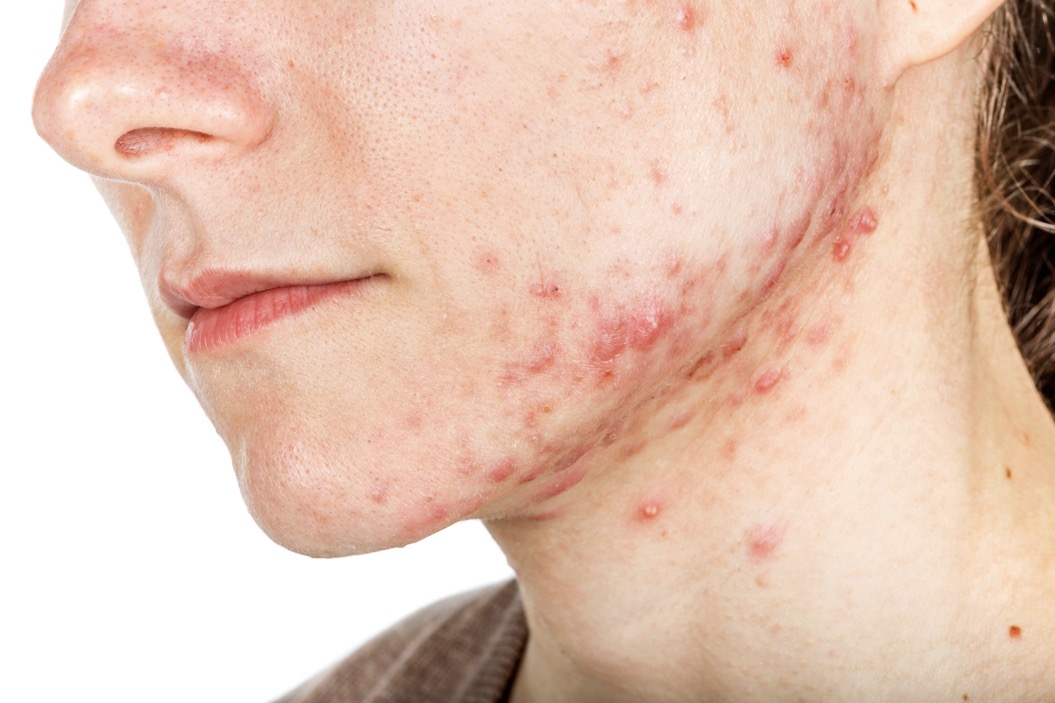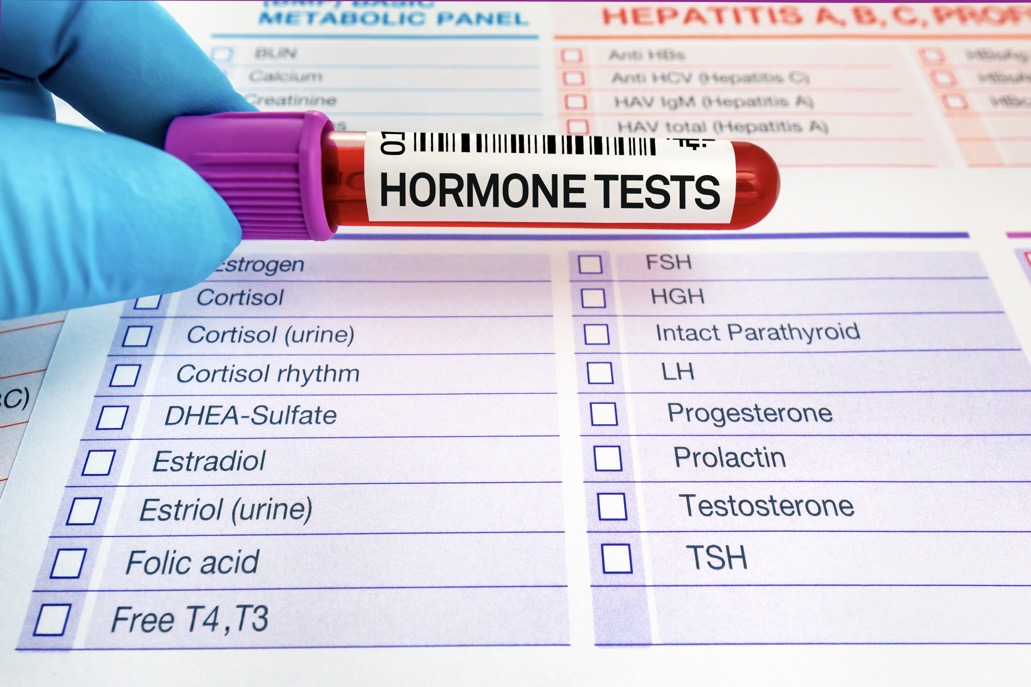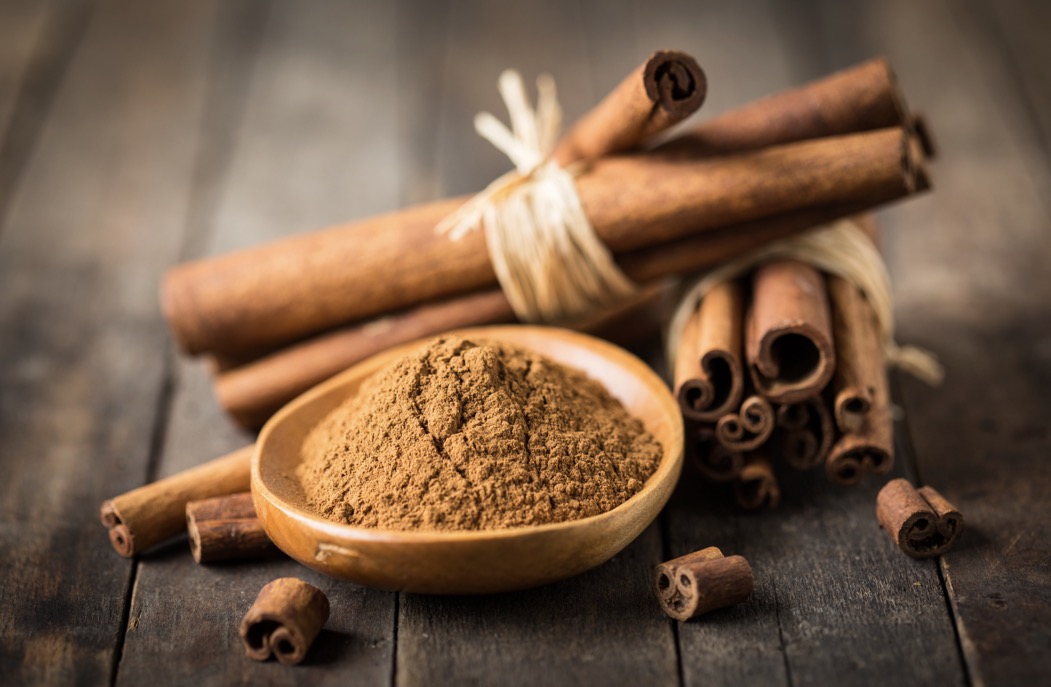What does PCOS acne look like?
It is estimated that between 30-48% of women with treatment-resistant cystic acne may have polycystic ovarian syndrome (PCOS) (Mehta-Ambalal, 2017). Acne may be the canary in the coal mine warning of a deeper endocrine disorder.
What are the signs PCOS might be at the root cause of your breakouts? Here are five things I look out for with my female acne patients.
- Stubborn acne that persists beyond the teenage years or starts in the mid-20s
- The lesions are in the hormonally sensitive areas of the face- jawline, neck, and chin. Some may also be on the back and chest. **These kinds of lesions can also develop after discontinuation of hormonal birth control—post-pill acne.
- The lesions are persistent tender knots under the skin rather than fine surface bumps. They are red, inflamed, and often sore. They may flare with the menstrual cycle, but they never fully clear.
- The lesions can lead to scarring and hyperpigmentation.
- Topical treatments and systemic isotretinoin aren’t effective.
What is PCOS?
PCOS is an endocrine (hormonal) disorder which may affect up to 10% of women of reproductive age (Yurtdaş & Akdevelioğlu, 2020). There is no absolute scientific consensus on what constitutes PCOS, and the current thinking is that it is no single pathophysiology but rather several different symptoms which are linked by a disturbance of ovulation and subsequent reduced or absent progesterone exposure (Briden, 2022; Teede et al., 2023).
Although many healthcare professionals consider PCOS to be primarily about fertility and nothing to worry about unless you want to fall pregnant, this does women’s health a disservice as PCOS is a risk factor for cardiovascular disease, type 2 diabetes, fatty liver disease and dementia (Zarezadeh et al., 2023). These are all serious conditions which I’m sure most women would want to be aware of.
Because of this, diagnosing PCOS can be challenging and requires in-depth clinical questioning and interpretation of tests. The risk of misdiagnosis or overdiagnosis is high. Two critical criteria need to be present for PCOS-
- Evidence of high androgens either clinically or in test results
- Oligomenorrhoea (menstrual cycles longer than 35 days or less than 9 cycles per year) or anovulatory cycles where there is low or no progesterone.
If these two conditions are present, then other reasons for high androgens need to be ruled out, including hyperprolactinemia, late-onset congenital hyperplasia, hypothalamic amenorrhoea, or relative energy deficiency in sport (RED-s) (Teede et al., 2023).
What about polycystic ovaries on ultrasound?
This is an area where some of the disagreement with PCOS diagnosis lies. A pelvic ultrasound (USG) is routinely performed as part of the diagnostic workup for PCOS to assess the amount of small undeveloped ovarian follicles. While this sounds like it should be a definitive way to diagnose PCOS, it may not be a reliable indicator. Women’s health educator and researcher Laura Briden notes that “25-30% of women with normal androgens will have “polycystic” ovarian morphology and androgenic PCOS can present with normal ovarian appearance” (Briden et al., 2020). Does this mean the USG is pointless? No, but it shouldn’t be the sole criteria used to diagnose PCOS; irregular cycles and high androgens also need to be present.
What about obesity and PCOS?
A medical stereotype of PCOS was that it presents with obesity and high body mass index (BMI). While elevated androgens and lack of ovulation can trigger mechanisms that increase the chances of insulin resistance and metabolic dysfunction, these are a result of the initial hormone disturbance, not an initiating cause (Hussein et al., 2023; Zhao et al., 2023). BMI, in general, is problematic for assessing metabolic health. It is possible to have a “healthy range” BMI and still have increased visceral fat which is metabolically unhealthy. PCOS comes in all body shapes and sizes.
With all the above, it’s easy to see why PCOS can be missed in a medical system where 10-minute appointments don’t allow the time to see beyond the surface and accurately assess the complexity of this condition.
What causes PCOS?
Again, there are no definite answers. One hypothesis is that PCOS is an evolutionary adaption which causes increased abdominal fat accumulation and decreased insulin resistance (Dumesic et al., 2022). This would have increased ability to store energy and allowed pregnancy and survival of offspring when food was scarce. The modern world, with the ready availability of high-calorie foods and increasingly sedentary lifestyles, pushes what was once a helpful adaptation into a health risk -A classic case of evolutionary mismatch. This is supported by evidence that you are up to five times more likely to have PCOS if there is a family history (Zandi et al., 2010).
Understanding the cause of PCOS acne
PCOS contributes to acne by disrupting hormonal equilibrium, which changes the function of the sebaceous glands and the inflammation that often accompanies insulin and metabolic dysregulation (Carmina et al., 2022). **Often, in younger women, the metabolic dysregulation is very subtle, certainly nothing that would see them diagnosed with fatty liver or type 2 diabetes. It’s insidious, but it’s enough to chronically impact the skin. Skin conditions are often the first sign that something is out of balance in the body.
First hit- Ovarian and ovulation disturbance
The hormonal disturbance of PCOS causes persistently elevated luteinising hormone (LH), which messes with ovulation, resulting in low progesterone and elevated oestrogen. High LH stimulates theca cells in the ovaries to increase androgens. High androgens, in turn, alter the amount and composition of the sebum in the sebaceous glands (Franik et al., n.d.). The changes in the fatty acid profile in the sebum increase the virulence of Cutibacterium acnes, which causes inflammation and acne lesions. High LH also modifies gene transcription, further increasing androgens (Zygmunt et al., 2022).
Second hit- High androgens disrupt insulin
High androgens contribute to insulin dysregulation, resulting in a pathological positive feedback loop. Dysregulated insulin is no friend to the skin. High insulin increases the transformation of testosterone to the 5 times more active dihydrotestosterone (DHT) (Franik et al., n.d.; Mehta-Ambalal, 2017). Elevated insulin also causes the proliferation of skin cells (keratinocytes and fibroblasts), which increase comedone formation (the initiating step in an acne lesion). An insulin-promoting, high glycaemic index diet exacerbates this further by throwing more fuel on the dysregulated “metabolic fire” (Mehta-Ambalal, 2017). A third hit is that high insulin promotes visceral fat accumulation, contributing to systemic inflammation and liver dysfunction, further drivers of acne (Maleki et al., 2021).
The underlying pathophysiology is complex, and I have provided a somewhat simplified overview in the summary above. Check the reference list for papers which go into this in more detail (Briden, 2022; Briden et al., 2020).
A checklist of PCOS acne symptoms
Here is a summary of things that may warrant further investigation to see if PCOS drives your acne. Remember, you need to tick a few of these boxes, a single symptom does not a diagnosis make!
- An irregular menstrual cycle – 35 days or longer or less than nine cycles per year.
- Longer cycles are common in teenagers who have had menstrual periods for less than 3 years and are part of normal hypothalamic pituitary ovarian (HPO) axis maturation.
- Irregular menstrual cycles can occur after ceasing hormonal birth control. It can take up to 12-18 months “post-pill” for cycles to return.
- Cystic, painful acne in the chin, jawline, and neck, unresponsive to other treatment except possibly hormonal birth control.
- Clinical signs of high androgens
- Dark, thick hair growth on the chin, jawline, around nipples and from the pelvis to the belly button. Note- some ethnic groups naturally have higher hair growth on the sides of the face
- Skin tags- raised growth of skin, often around the armpits or under the breasts
- Acanthosis nigricans- darker velvety areas of skin creases of neck or underarms
- Thinning hair – androgenic alopecia
- Signs of metabolic dysfunction
- Weight gain around the abdomen, which doesn’t shift.
- A waist-to-hip ratio (WHR) of greater than 0.85. This is a better measure than BMI. To find this, measure your waist and hips at the broadest point and divide the waist by the hip measurement.
Blood Tests for PCOS
Blood tests are essential for making a PCOS diagnosis, especially in women in their late teens and early 20s. Be cautious in rushing into diagnosis for women under 18 years old, as it is expected in the early years of puberty to have higher androgen levels.
Test timing is important – both the time of day and the menstrual cycle.
Get the blood draw done around 8 a.m. after an overnight fast of 8-12 hours. Some hormonal tests must be done at specific times of the menstrual cycle. For example, progesterone should be tested as close to the mid-luteal phase (around seven days before the next expected period). If tested in the follicular phase, it will be low. You need to ovulate to make progesterone. Luteal phase testing can be tricky to estimate for those with irregular cycles.
Essential
Androgens
Testing for androgen levels is important for PCOS diagnosis as it is possible not to have any of the clinical signs mentioned above and still have biochemically elevated androgens. I recommend getting tested for three androgens. Test in the follicular phase of the cycle (day 3-5)
- Total Testosterone + Sex hormone binding globulin (SHBG)
- DHEA-S
- Androstenedione
Reproductive Hormones
- Luteinising hormone (LH) – test on day 3-5
- Follicle-stimulating hormone (FSH) – test of day 3-5
- Prolactin – to rule in or out hyperprolactinaemia -test on day 3-5)
- Progesterone – test in the luteal phase, ideally seven days before the next expected period.
- Oestradiol (oestrogen) – luteal phase
Other hormones
- Fasting insulin – test at any time of the cycle (test after 8-12hr overnight fast). Any longer than 12hrs and the number might not be as relevant.
- 17 alpha hydroxyprogesterone (17-OHP) to rule in or out late-onset congenital adrenal hyperplasia. Test on days 3-5.
Other tests
- Fasting blood glucose
- Electrolytes and liver function
Optional test depending on clinical history
- Vitamin D
- Thyroid function including thyroid antibodies
- Anti Mullerian Hormone (AMH)
As you can see, quite a few tests are needed to give the full clinical picture.
The next phase involves working with an experienced clinician to combine the clinical symptoms with the test results and reach a diagnosis. Then, a treatment plan can be implemented.
Medical treatments for PCOS
Combined oral contraceptive pill
The combined oral contraceptive pills (COCP) is often a first-line prescription for PCOS and acne. The COCP contains synthetic oestrogen and progestin. The synthetic oestrogen in the pill can reduce sebum, and it also raises SHBG, which can reduce androgens. This is commonly prescribed for PCOS. Regular withdrawal bleeds reduces the risk of endometrial hyperplasia (“The Clinical Practice of Acne Treatment in Polycystic Ovary Syndrome,” 2021). Progestin-only pills, implants or hormonal IUDs like Mirena may exacerbate PCOS (Briden, 2022).
COCP will not change the underlying hormonal issue with PCOS; it simply masks it, and it’s not suitable if you are looking to conceive. However, many women do find it effective for symptomatic acne control.
Spironolactone
Spironolactone is a moderate anti-androgen. It blocks testosterone receptors, reducing the sebum in the skin. Read more about spironolactone and acne here.
Isotretinoin
Also known by the brand names Accutane or Roaccutane, isotretinoin (13 cis retinoic acid) is an acne medication. It is a synthetic retinoid derivative of Vitamin A that works by altering sebum output and reducing inflammation. It is a powerful medication with many potential side effects and is not recommended for long-term use. Often, people with PCOS acne find benefits while taking it, but the acne returns when it is discontinued.
Metformin
Metformin is an insulin-sensitising drug used to manage Type 2 diabetes. It has shown benefits for PCOS, even in those not diagnosed with diabetes. A 2019 study found that 1500mg a day of metformin reduced acne lesion scores, testosterone, DHEA-S, and hirsutism (Sharma et al., 2019). Compliance with metformin can be variable, as gastrointestinal side effects are common.
Natural treatments for PCOS acne
Natural treatments for PCOS acne use a holistic and individualised approach aimed at-
- Improving insulin sensitivity (if insulin resistance is present)
- Reducing androgen excess
- Restoring ovulatory menstrual cycles
Improve insulin sensitivity and reduce insulin requirements
Even though insulin dysregulation is a secondary effect of PCOS, it is one where there are many things we can do to modify it. Even if you’re a “normal” weight woman, it can be beneficial to keep insulin in balance. The best bang for your buck regarding insulin management are diet, exercise and sleep. Think of these as permanent lifestyle changes so you choose things you can enjoy and keep up over the long term. The other benefit of these are there are no additional costs to you. You were going to be eating anyway!
Exercise
There’s no doubt regular exercise is generally health promoting. Daily movement is particularly important for PCOS as it improves insulin and androgen sensitivity. It also supports psychological well-being. Studies have shown that 12 weeks of 5 x 30 minutes of moderate-intensity aerobic exercise (like brisk walking) improves ovulation and menstrual cycle regularity (Colombo et al., 2023). Other studies have also shown benefits with 75 minutes (5 x 15 minutes) for high-intensity interval training (HIIT) (Ribeiro et al., 2021).
If you haven’t been exercising much or have an injury, work with your doctor or physical therapist to get a program specific to you. My top tip is to worry less about the amount of time and be consistent. Can’t do 30 minutes? 15 minutes is better than none. Perhaps you can do 2 x 15-minute sessions a day. You could even factor it into your normal activities. Park further away from work or get off at an earlier bus stop.
Diet
Because PCOS is linked with reduced insulin sensitivity, a diet pattern that is low glycaemic can be beneficial (Saadati et al., 2021). Limit refined sugar, alcohol and ultra-processed foods. The key word here is “limit”. I’ve seen some PCOS diets which are very restrictive, making them impossible to sustain over the long term. They also are often not great for mental health and create fear around foods.
Think about the quality of the foods in your diet. It’s not about calorie counting. A large salad and a doughnut have the same calories but a very different effect on your health. Low-calorie diets can mess things up by further reducing the ability to ovulate and interfering with thyroid function.
I often talk with my clients about the 80 to 20 balance. Hit the healthy targets 80% of the time, leaving 20% leeway. Include high-quality protein, plenty of vegetables, small amounts of fruits, and healthy fats. Diet and nutrition are complex and need to be personalised. Work with a nutritionist or dietician to provide guidance.
Sleep
Women with PCOS are prone to sleep disturbances. Changes in sleep architecture can result in difficulty falling asleep and staying asleep (Sam & Ehrmann, 2019). Abdominal weight gain and reduced progesterone can contribute to obstructive sleep apnoea (OSA), resulting in excessive daytime sleepiness and difficulty concentrating.
Women with PCOS are not starting on a level playing field when it comes to sleep, so it’s important to pay particular attention to the things which can promote good sleep, including-
- Allowing enough hours to get the amount of sleep you need
- At least 30 minutes per day of sunlight exposure (without sunglasses) to support melatonin
- Robust sleep hygiene practices are essential. The most important include stopping scrolling, switching off screens at least an hour before bed, and dimming the lights.
- Allow at least two hours after your last meal and bedtime
- Investigating any symptoms of OSA with your doctor.
Nutritional and herbal supplements for insulin resistance in PCOS
Myoinositol and cinnamon have both shown benefits in improving insulin sensitivity in PCOS patients. They are best used in combination with diet and lifestyle support. I advise consulting with a nutritionist or Naturopath before supplementation to see if these are right for you.
Myoinositol
Myoinositol has been well-studied for its benefits in PCOS. It has been shown to have equal efficacy with metformin, an insulin-sensitising drug, without the accompanying gastrointestinal side effects (Fruzzetti et al., 2017). It also supports the balance of other hormonal pathways, including FSH and LH. For this reason, PCOS without insulin resistance may also benefit from myoinositol. The dose most often used in research studies is 2 grams twice daily, and results are seen in 8-12 weeks (Benelli et al., 2016; Greff et al., 2023).
Cinnamon
Cinnamon’s anti-diabetic, anti-inflammatory, and antioxidant properties make it a useful herb for managing PCOS. The most solid research supports its ability to improve insulin sensitivity, but the antioxidant properties of cinnamon may also have a protective effect on ovarian tissue, which can help promote menstrual cycle regularity (Maleki et al., 2021; Xiaomei & Xiaoyan, 2024).
There are many different species of cinnamon, and the one most studied is Cinnamomum verum (Ceylon cinnamon). Another species, Cinnamonum cassia, is high in coumarins, making it unsuitable for longer-term use. The dosage used in studies is 1-1.5 grams per day for anywhere between 8 weeks to 6 months (Maleki et al., 2021; Zarezadeh et al., 2023).
Reducing LH and androgen excess
The diet, exercise and lifestyle information above is equally applicable to reducing LH and androgen excess.
Exercise
A healthy body fat percentage is crucial to supporting the balance of LH- FSH. FSH is blocked when body fat rises above 26-28%. Even a slight decrease in body fat percentage will be helpful. You’ll need a DEXA scan for accurate body fat readings, which is available without a referral in most places. Body fat needs to be in a sweet spot, as being too low will also disrupt menstrual cycles. This may happen when body fat drops below 17%, although some women can maintain fertility with lower percentages.
Herbs and supplements for androgen excess
Herbs and supplements which may support androgen reduction include-
- Peony and Licorice
- Spearmint
- Reishi
- Zinc
- Sulforaphane
Read more detail about natural anti-androgens and their mechanisms of action in my post, Natural anti-androgens for acne.
Restoring regular ovulatory menstrual cycles
Things that will hinder ovulatory menstrual cycles in all women of reproductive age include nutritional deficits and psychological or physical stress. Addressing these are foundational in resolving PCOS acne. Think of it as optimising your baseline.
Once you’ve addressed diet and lifestyle, nutrients and herbs which may support regular menstrual cycles and ovulation include-
- Essential fatty acids
- Myoinositol
- Zinc
- Iodine (only if deficient, and caution is needed if you have a thyroid condition)
- Vitex agnus castus
- Black Cohosh
Supplemental menstrual support is nuanced and really does need to be personalised with dosage and timing, so I recommend working with an experienced and qualified practitioner.
Key takeaways about PCOS acne – treatment
- Get a correct diagnosis. Is it PCOS, or is there some other reason for high androgens and irregular menstrual cycles?
- Get the proper tests done at the right time.
- A holistic approach encompassing diet and lifestyle is essential. Taking a supplement on its own usually won’t get results you want.
- True PCOS is a lifelong condition, so implement diet and lifestyle changes you can maintain over the long term.
- Supplements work best when they are targeted to suit your individual circumstances. No single “protocol” works for everyone.
- PCOS acne treatment is a long(ish) game. Improvement is usually noticed around the 12–16-week mark.
If you enjoyed this article, you might also like-
Natural anti-androgens for acne
References are available on request.

Need help with your skin?
Norelle Hentschel is an experienced Naturopath with a clinic in Stones Corner, Brisbane and Telehealth consults Australia-wide. She has helped many clients clear up their skin conditions and improve their health.
Want more articles like this?
Join us at Your Skin Remedy – the monthly missive for healthy skin from the inside out. Practical, actionable, and informative. Your clear, glowing skin starts here.
PS. Your inbox real estate is precious. Your Skin Remedy is pitch and promo free. I promise. One email a month — that’s it.




